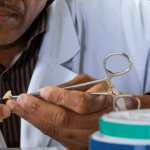‘Looking to the future’
Hans Joit introduced digital technology into his Dusseldorf dental laboratory 10 years ago, and it has transformed the way he works.
Interview with Hans Joit, Dusseldorf, Germany
3 October 2018
Based in the centre of the German city of Dusseldorf, Hans Joit’s dental lab employs around 40 people, providing a highly specialised service to their dental clients.
Before making a start on their case, dentists refer their patients to Hans, and they come to the lab in person to have all the images and documentation carried out. This is then transmitted back to the dentist, so that dentist and technician can work together to achieve the best possible outcome for the patient.
Hans, who is highly specialised in working with ceramics, as well as zirconia and new materials such as Celtra, began making the shift to digital technology around 12 years ago.
“I started to look into CAD/CAM, but after trying various options I realised that I needed to have the flexibility to design my own frameworks, because no-one could offer me exactly what I wanted to produce,” he said. “I wanted to have the control in my own hands.”
By 2008 he had the scanner and the milling unit that he wanted from Sirona and was working successfully with it.
It took practice and patience to get the best out of the technology, he explained. “It’s like learning an instrument – someone can teach you but you need to practise and work it out for yourself.”
The impetus to introduce digital technology was mainly to achieve greater precision, but with the workflow planning he has found it possible to work more effectively with his dentist clients, not only the local ones who send their patients to him in person, but also those who are further away and with whom he communicates digitally. It has also helped their communication immensely.
“I see the case from the prosthetic side, while they see it from the medical side, and sometimes we identify different problems or have different solutions,” he said. It really helps that both parties can have the images in front of them at the same time. “Sometimes the preparation doesn’t quite fulfil the requirements, or a problem may arise and we can discuss it and make changes instantly,” he said.
It also enables the dentist to be as involved as they wish in the process. “Some dentists just want to hand the case largely over to me to sort out, while others prefer to have more control, or to mill the item for themselves, and they can use me as much as they like,” he said. “I just try to give them what they want!”
The lab can offer design services, mill and produce the piece, or work with the dentist as much or as little as the client chooses. Turnaround times have improved greatly, as well as the predictability of the result.
“If the dentist is involved with the workflow you can get more efficient production,” he said, “and using the machine means I can get the same result a thousand times.”
Hans loves that the digital technology has made it possible to use new, better and more aesthetic materials, like the glass ceramic Celtra – and to promote them to dentists.
“It gives an excellent outcome; it looks good and is very stable,” he said. “I am able to show these new materials to my dentist clients, lead them by the hand and show them the future. Using the new materials alongside the digital technology means that we can produce better results, and both we and the dental office can benefit from that.”
He sees the machine as enhancing the work of the technician. “The machine will do the work that you tell it to,” he said, “but you are still the brain operating it, the person who feeds the information into the machine, and the work it does depends on the quality of that information. We have to learn to speak the language of the machine.”
Hans is first and foremost a technician who enjoys the fine points of his work, such as complex veneering, and the work of the lab is divided among the staff to fit their talents best. He employs a technician with the highest computer skills to operate the technology, creating the frameworks while he oversees their work and carries out the fine finishing work himself.
The technology lends itself well to this division of labour, enabling all the team to play to their abilities, and one skilled technician working the machinery can carry out the work far faster than previously.
“There are always manual steps within the process,” he explained, “and different people have different skills. You have to be able to switch from analogue to digital work and back again to produce the best results.”
Hans’ work is highly specialized and sought after by his dentist clients, offering the highest aesthetics alongside precision and the ability to collaborate closely. Digital technology, combined with the latest materials, enables him to offer them the best possible service.








